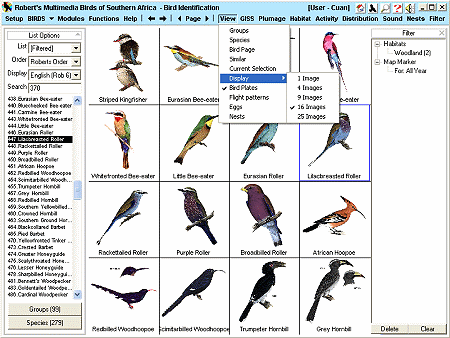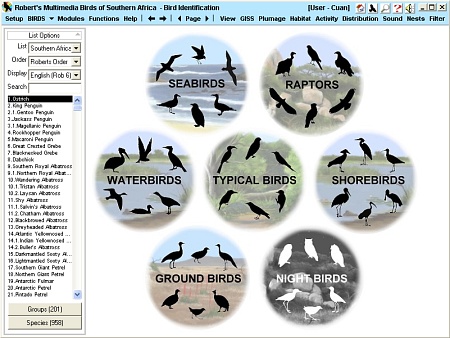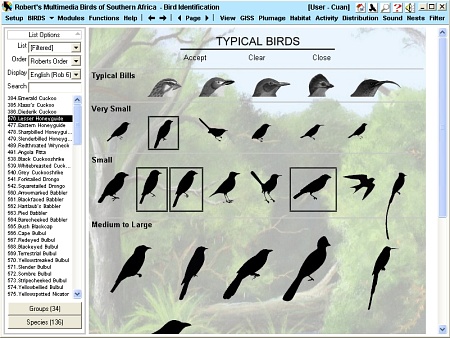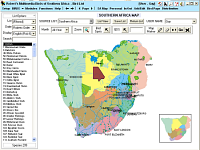
The identification module has been designed to aid you in
reaching a decision on a bird's identification. The recommended method is as follows:
- Use simple observations such as [ GISS] (general impression,
size and shape), [Habitat] and [
Distribution], to narrow down the possible species.
- Illustrations of the short-listed birds are displayed in a grid for comparison.
You can now use View to select the type of image to view.
- Now apply [Plumage] and [ Activity]
to further shortlist the species.
- Open a [Bird Page] to confirm your identification.
- 5. Use [View - Similar] birds for detailed comparison.
The shortlist can also be carried to the [Sound]
and [Nest and Egg] modules for further processing.
The [View] option allows you
to select the type and number of images on view.
[Filter] keeps track of your selections, and allows
you to edit these. You can watch the progress of your selection in the bird list
and view area, and then de-select a selection if you run out of species!
Identification Module functions
View, GISS, Plumage, Habitat, Activity,
Distribution
View
The Identification - View function enables you to change the way the identification
module page is displayed and what type of illustrations or photographs are viewed.
You can view the family groups or individual species, view flight pattern illustrations
and browse nest and egg photographs of the birds in the list. The function also
allows you to set how many illustrations or photographs are displayed (1, 4, 9,
16 or 25).

GISS
The Identification - GISS page is designed to enable
you to identify a bird based on general impression, size and shape (GISS). This
identification uses seven GISS pages to help you identify
a bird. The profiles pages are:
- seabirds,
- raptors,
- waterbirds,
- typical birds,
- shorebirds,
- ground birds and
- night birds.
Each profile page has various silhouettes of birds that
are arranged and sized proportionally. The aim is to select certain profiles that
you think looked like the bird you observed in the field. You can make multiple
selections on each profile page and each time you select a profile, birds are added
to the list that correspond to the selection you made. This is an additive process,
and therefore does not eliminate birds that may have been the one you observed.
You can also deselect profiles and clear the profile page of any selection. Once
you have made your selections, you click [Accept] and go to the Identification view
page where you can browse the shortlist of birds.
GISS page
The GISS page is the first identification page of the Identification
module. Here you select one of the GISS pages to start
the identification process.

GISS pages
There are seven profile pages:
- Seabirds - this page shows
birds that occur in a marine and marine shoreline habitat (gannets, gulls, terns,
cormorants, penguins, albatrosses, petrels, stormpetrels etc).
- Raptors - this page shows
all the birds of prey (goshawks, sparrowhawks, kites, hawks, falcons, kestrels,
harriers, chanting goshawks, buzzards, eagles and vultures).
- Waterbirds - this page
shows birds that occur in an inland water habitat such as a dam, wetland and river
(gulls, terns, rails, crakes, bitterns, gallinules, jacanas, pelicans, cormorants,
ducks, geese etc).
- Typical Birds - this
page shows the typical bird profiles, that is birds with distinctive shapes (hornbills,
kingfishers, hoopoes, rollers, woodpeckers, parrots, starlings, doves, crows, louries,
coucals, cuckoos, barbets, batises, finches, waxbills, sunbirds, thrushes etc).
- Shorebirds - this page
shows the birds that occur in along the shoreline of habitats, such as estuaries,
wetlands, dams, rivers and marine (waders - sandpipers, stints, dikkops, oystercatchers,
plovers, herons, night herons, egrets, flamingos, storks, ibis, spoonbill etc).
- Ground Birds - this
page shows birds terrestrial dwelling birds (cranes, storks, bustards, korhaans,
ibis, francolins, plovers, quails, flufftails, sandgrouse, doves, pratincoles etc).
- Night Birds - this
page shows the nocturnal birds (owls, nightjars, plovers, dikkops, coursers, quails,
flufftails etc).

Typical Operation
- Identify
a bird using profiles
The aim is to identify a bird that you saw in the field by using the
profile pages. The selections you make on the profile pages give you a shortlist
of possible birds, which you can then browse by selecting the bird in the list on
the left.
Plumage
The Plumage function enables you to make selection based on the plumage of a bird
that your observed in the field. The function has the following options which can
be selected to aid you in the identification process: plumage, underparts, throat,
collar, breast, flanks, upperparts, wings, rump, undertail, tail, head, eyes, bill
and legs. Each of these has examples that can be selected to narrow down the number
of birds in the list.
Habitat
The Identification - Habitat function enables you to select a habitat to
use as a filter in the identification process or to browse through the birds that
occur in the particular habitat. You are able to select multiple habitats. The Habitats
that you can select are as follows: Forest, Woodland, Kalahari, Grassland, Karoo,
Desert, Fynbos, Mountains, Rocks Cliffs, Towns, Farmland, Inland Water, Marine Pelagic
and Marine Shoreline. There is also an option to link to the habitat map in the
Habitat module.
Activity
The Identification - Activity function enables you to select various activity
criteria to use as a filter in the identification process. The criteria are as follows:
- Flight patterns,
- Tail patterns,
- Characteristic movements and/or postures,
- Swimming patterns,
- Wading patterns and
- Other features.
Distribution

The Identification - Distribution function links directly
to the SA Map in the Bird List module. Here you can select the region or area you
were in when you observed the bird you are now trying to identify. The selection
can be done in the following ways:
- Zoom into the appropriate area. Use the Map Marker tool
 to draw the area on the SA Map, then select [GO] and a list will be created for
the area.
to draw the area on the SA Map, then select [GO] and a list will be created for
the area.
- Zoom into the appropriate area. Use the QDS tool
 to highlight the area you want to select and click on the map. A list for that QDS
will appear in the list panel on the left.
to highlight the area you want to select and click on the map. A list for that QDS
will appear in the list panel on the left.
- Zoom into the appropriate area. Locate the birding spot
you were at when you observed the bird and use the Bird Spots tool
 to select the spot (click on the red dot). A filtered list will appear in the list
panel on the left.
to select the spot (click on the red dot). A filtered list will appear in the list
panel on the left.
Once you have the filtered list on the left, you can click
[Return List] on the menu bar and it will link back to the Identification module
with the filtered list. Now you can browse the birds in the list or select another
filter to narrow down the list further.
For more detail, consult
Bird Lists: SA Map Module

|